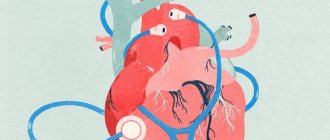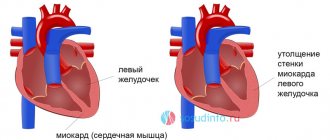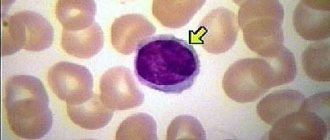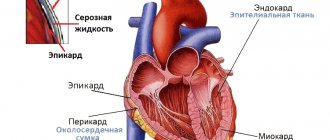General information about pathology
Cardiomegaly is popularly called “bull’s” heart. This is due to the fact that the heart increases significantly in size. Normally, this organ weighs from 270 to 370 g in men, and 200–300 g in women. With pathology, the weight of the heart can reach 600–900 g.
With cardiomegaly, there is an increase in the size of all cavities of the heart. The cavities of the ventricles or atria can stretch 2 or more times. Hypertrophy and thickening of the heart muscle is also observed.
Changes in myocardial size lead to functional disorders and the development of progressive heart failure. The patient experiences various rhythm and conduction disturbances, symptoms of congestion in the systemic circulation.
With congenital pathology, children die before the age of 3 months or remain severely disabled.
How to treat heart pain?
Cardiomegaly is not a symptom of coronary artery disease. But an acute heart attack, prolonged attacks of stable and unstable angina, and signs of atherosclerosis can lead to hypertrophy and dilatation (expansion of the cavities) of the heart. A left ventricular aneurysm dilates the heart and causes narrowing of the coronary arteries.
Therefore, pain in the heart area can be of the nature of attacks, radiating to the left shoulder, shoulder blade, jaw, and can be relieved with nitroglycerin.
The nature of pain during pericarditis and pleurisy depends on the position of the body, intensifies when swallowing, when inhaling, and decreases when bending forward.
Some patients feel normal for a long time or do not associate fatigue and shortness of breath with heart disease. Therefore, the doctor needs to find out in a conversation the presence of initial clinical manifestations.
Causes and features of the development of pathology
The causes of cardiomegaly can be congenital or acquired. Purchased items include:
- Malignant arterial hypertension.
- Defects of the mitral, tricuspid valve or combined.
- Acute or chronic myocarditis, endocarditis, pericarditis.
- Common vascular atherosclerosis.
- Cardiomyopathies.
- Cardiac ischemia.
- Hormonal cardiomyodystrophy.
- Malignant or benign tumors of the heart.
- Thrombophilia.
- Violation of the blood coagulation and anticoagulation systems.
- Pathology of the pulmonary system.
- Autoimmune systemic diseases.
Also, “bull’s heart” can develop in people who abuse alcoholic beverages, especially beer, for a long time.
Congenital cardioomegaly is mainly genetic in nature. Predisposing factors for its appearance are:
- Use of alcohol, tobacco, and drugs during pregnancy.
- Late onset of pregnancy (over 35 years of age).
- Intrauterine infection with the herpes virus, Epstein–Barr.
Alcohol consumption is a possible cause of cardiomegaly.
It must be understood that normal enlargement of the heart is not cardiomegaly. Normally, the mass of the myocardium and the size of this organ can be increased in large, tall people with a hyperstonic physique and in athletes. In this situation we are talking about myocardial hypertrophy. This condition is not a pathology and does not require treatment.
With cardiomegaly, under the influence of an inflammatory or infectious process, heart cells (cardiomyocytes) are affected. This triggers an autoimmune reaction, producing inflammatory mediators that further destroy the heart muscle.
Cardiomyocytes are replaced by fibrous (scar) or connective tissue. The myocardium loses its ability to elastically stretch. As a result, the contractile and pumping functions of the organ are reduced. A large heart is not able to fully pump blood. Foci of sclerosis and dystrophy appear in the muscular lining of the heart, and its cavities expand. In this case, the myocardium can be hypertrophied or remain unchanged.
Cardiomegaly in fetuses and children
Enlargement of the heart, which occurs during the prenatal period, is a congenital and very serious disease. Cardiomegaly in the fetus can develop due to the impact of negative factors on the pregnant woman during the formation of the cardiovascular system, which begins to develop in the embryo very early - from the second to the eighth week. That is, already on the 17th day the cardiogenic plate begins to take shape, and by the beginning of the third month of pregnancy, the embryo has already formed a four-chambered heart.
So, the negative factors that affect the cardiovascular system of the unborn child:
- Ionizing radiation, including X-rays, radiation,
- Viral diseases of the mother, especially rubella, severe strains of influenza, cytomegalovirus infection, herpes, etc.
- Smoking, alcohol, drugs,
- The use of certain drugs, for example, anticonvulsants, barbiturates, etc.
- Severe diet violations, starvation, exhaustion, serious vitamin deficiencies.
In addition, heredity cannot be ruled out, especially on the maternal side.
As a result of these factors, the fetus may develop heart defects, for example, Ebstein's anomaly, which most often leads to moderate cardiomegaly. As a rule, cardiomegaly in the fetus is combined with other developmental defects, as well as with congenital chromosomal disorders, for example, Down syndrome. In a small proportion of cases, there is no apparent cardiac cause for cardiomegaly in the fetus, which is why this type of disease is called idiopathic cardiomegaly.
The symptoms of the congenital disease are very characteristic and typical - the child immediately after birth experiences cyanosis of the face or the whole body, shortness of breath when crying and sucking, and severe tachycardia. To confirm the diagnosis in newborns, methods such as chest x-ray and cardiac ultrasound are used.
The prognosis of congenital cardiomegaly is questionable, since after birth infants survive in 45% of cases, die in 30% of cases, and the remaining children have serious cardiac abnormalities, however, compatible with later life.
Of course, if a cause is identified, for example, a congenital heart defect in the fetus that leads to cardiomegaly, it is easier for doctors to act, in contrast to the idiopathic form of the disease, when there is no apparent cause. Thus, modern personnel and technical equipment in some perinatal centers and cardiovascular surgery centers makes it possible to operate on a baby in the first days after birth, and subsequently to deliver the newborn and give him a chance for a healthy existence.
Cardiomegaly in children of early, preschool and school age is formed in the case of uncorrected congenital or acquired heart defects. Symptoms mainly boil down to the following:
- The appearance of tiredness, tiredness,
- Poor appetite
- Sleep disorders
- Poor performance at school,
- Neurological disorders,
- Psycho-emotional lability.
Diagnosis and treatment in the case of acquired cardiomegaly are not much different from those in adults.
Classification of cardiomegaly
In the modern classification, several types of cardiomegaly are distinguished:
- Congenital. Occurs in utero. Has a severe course. It is not subject to conservative therapy; it is always treated surgically.
- Idiopathic. It can develop in healthy people without objective reasons. Occurs rarely.
- Acquired. In this case, the prognosis of the disease depends on the existing chronic pathologies of the cardiovascular system.
- Physiological. It occurs in people who are overweight or who play sports professionally.
Alcoholic cardiomegaly also sometimes occurs. Its main cause is the adverse effects of ethanol on the heart muscle.
There is another classification of this disease. According to her, cardiomegaly occurs:
- Dilatational. Under the influence of pathological factors, the production of contractile proteins decreases and the metabolism of cardiomyocytes is disrupted. All cavities of the heart expand and dilatation occurs.
- Restrictive. With this disease, the heart is enlarged in size, but the leading factor is impaired contractile function. The myocardium is compacted and thickened. The cavities of the ventricles are reduced, and the atria are significantly expanded. The risk of thrombosis and thromboembolic complications increases.
- Hypertrophic. The most common type of cardiomegaly. The myocardium of the left ventricle is mainly affected.
Also, cardiomegaly can be symmetrical or asymmetrical. With the symmetrical version, all parts of the heart increase evenly. With an asymmetrical form of the disease, individual cardiac cavities thicken and hypertrophy.
Algorithm for a doctor’s actions when cardiomegaly is detected
If a doctor receives a conclusion about an enlarged heart, his tactics must necessarily include further examination, finding out the causes, and choosing a treatment plan.
The algorithm of actions includes all stages:
- It is necessary to confirm the truth of cardiomegaly.
- Put questions to the doctors of the diagnostic rooms: which chamber of the heart is enlarged and by how much, whether there is hypertrophy or dilatation of the departments.
- Find out the cause by interviewing the patient, studying documents, and medical history.
- Assess the degree of cardiac dysfunction.
- Check symptoms.
- Determine treatment tactics: preventive measures (diet, regimen, exclusion of risk factors for ischemia, antihypertensive drugs); prescribe the required dosage of medications for treatment (glycosides, diuretics, β-blockers, nitro drugs, calcium antagonists); advise the patient on the issue of surgical intervention (elimination of heart defects, coronary artery stenting, bypass surgery).
Clinical manifestations
The clinical picture of cardiac cardiomegaly is nonspecific. Its manifestations resemble various diseases of the cardiovascular system. The patient experiences:
- A feeling of discomfort in the chest, mainly in the area of the apex of the heart.
- Various breathing disorders: tachypnea, bradypnea, orthopnea.
- Tachycardia, sinus or respiratory arrhythmia, atrial fibrillation.
- Feeling of interruptions in the heart.
- Increased fatigue, drowsiness, weakness.
Patients also complain of signs of cardiomegaly such as dizziness, unsteadiness when walking, fainting or presyncope. However, remember that these symptoms can also appear with other heart diseases.
Symptoms
In the early stages of its occurrence, cardiomegaly is asymptomatic. And it can be diagnosed after cardiac examinations, prescribed by a specialist for other reasons.
The pathology has no specific clinical manifestations. However, there are a number of symptoms that signal a person to seek medical help:
- increased shortness of breath, its appearance even during normal physical activity;
- previously uncharacteristic increased fatigue;
- excessively swollen vessels protruding from under the skin, overflowing with blood;
- severe swelling of tissues, especially of the lower extremities;
- frequently occurring painful sensations in the area of the projection of the heart.
In children, warning signs include:
- deviation of pulse parameters from the age norm, tachycardia;
- lack of appetite for a long time;
- excessive sweating even in the absence of physical overload;
- pale skin tone in the area of the nasolabial triangle.
A timely visit to a cardiologist and timely treatment measures significantly increase the baby’s chances of recovery.
Many of the above symptoms can be attributed to manifestations of other diseases. Cardiomegaly is characterized by a hidden course, disguised as various cardiovascular disorders.
During the consultation, the person points out complaints such as discomfort in the left half of the chest that occurs after physical or psycho-emotional stress. This condition can be relieved by taking regular sedative drops, for example, Valocordin. This is a distinctive sign from angina pectoris, during an attack of which pain impulses can be eliminated with nitroglycerin drugs.
As a rule, it is possible to suspect the presence of cardiomegaly after diagnostic procedures for manifestations of heart failure. These include:
- rhythm disturbances;
- severe shortness of breath;
- frequent dizziness;
- decreased ability to work.
For a long time, many people find various excuses for such a deterioration in their own well-being, citing the following reasons:
- overwork;
- sedentary lifestyle;
- transferred infectious pathologies.
While early detection and treatment help to quickly cope with the disease.
Diagnostics
This disease cannot be predicted after a simple interview and examination of the patient. To diagnose cardiomegaly, the following instrumental methods are used:
- ECG. On the recorded film, indirect signs of pathology are determined: hypertrophy of the left or right parts of the heart.
- X-ray of the chest cavity. With cardiomegaly, an increase in the size of the heart can be seen on the x-ray. The image also reveals dilation of the ventricles or atria.
- MRI of the heart. Using this method, the weight of the myocardium, its thickness, and the presence of pathological changes in the cavities are diagnosed.
- CBC, biochemical analysis, PTI, blood clotting test. They are carried out to identify inflammatory, allergic or autoimmune disorders.
- Ultrasonography. One of the most effective ways. Thanks to it, it is possible to identify the severity of the pathology and determine the functional ability of the myocardium.
ECG is a method for diagnosing cardiomegaly.
Biopsy, scintiography of the heart muscle, or myocardial catheterization are also used to diagnose cardiomegaly. The diagnosis is made only after instrumental confirmation of the disease.
Be sure to carry out differential diagnosis with myocarditis, infective endocarditis, congenital and acquired heart defects.
Why does a child's heart enlarge?
Cardiomegaly can be congenital and detected in the fetus during an ultrasound examination of a pregnant woman. This pathology is considered very rare, but dangerous. About 1/3 of newborns diagnosed with such a pathology die in the first 3 months. And 1/4 develop chronic left ventricular failure.
The following causes of pathology in children have been established:
- infectious diseases of the mother during pregnancy;
- maternal smoking;
- unfavorable ecology, ionizing radiation;
- mutation at the genetic level;
- congenital heart defects.
The formation of Ebstein's anomaly, a rare congenital defect (1% of all types), is associated with the development of cardiomegaly. The defect is formed by a combined lesion:
- tricuspid valve in the right atrioventricular orifice;
- non-closure of the interatrial foramen ovale;
- reduction in the size of the right ventricle.
The size of the fetal heart doubles. At the same time, blood clots are detected in the cavities.
Acquired pathology in childhood is associated with previous infections complicated by allergic myocarditis.
Therapy methods
Cardiomegaly syndrome is treated conservatively and surgically. The choice of the necessary method of therapy is determined by a doctor - a cardiologist or cardiac surgeon.
This pathology cannot be eliminated without treating the underlying disease. Drug therapy is indicated for adults and children with congenital or acquired forms of the disease.
Patients are advised to follow a diet limited in salt, liquid, fatty and fried foods. It is also necessary to limit psycho-emotional stress, monitor pulse and blood pressure.
Medication
For the conservative treatment of cardiomegaly, the following groups of drugs are used:
- Cardiac glycosides. Reduce myocardial oxygen demand and normalize all cardiac functions. They dilate coronary veins and arteries, normalize metabolic processes. Increase the contractility of the heart.
- Loop, thiazide or potassium-sparing diuretics. With their help, you can remove water from the body and eliminate peripheral edema. Due to this effect, these drugs significantly reduce the load on the myocardium.
- ACE inhibitors. They reduce blood pressure and promote the reverse development of left ventricular hypertrophy. Restore vascular tone.
- Beta blockers and antirhythmic drugs. Normalizes heart rhythm, reduces heart rate. Dilates the blood vessels supplying the myocardium, normalizing the speed of blood flow.
- Metabolic and antianginal drugs. They improve hemodynamic parameters and increase coronary reserve.
Sometimes combination therapy is used: a combination of medications and surgery.
Surgery
Used when there is no effect from other treatment options. The main types of surgical interventions include:
- Installation of EX.
- Replacement of a heart valve with an artificial or bioprosthesis.
- Aorto – coronary bypass surgery.
In severe cases, with cardiac decompensation, heart transplantation is recommended.
Forecast
When diagnosing bovine heart in a person, the doctor will definitely not be able to say how long the patients will live with the pathology according to the prognosis. For children with a congenital disease, the prognosis in half of the cases is poor, since 50% of infants with the disorder die immediately after birth, and a third of those who survive die in the first 3 months of life. In other cases, therapy improves the patient's condition, but the risk of sudden death is high, so the prognosis remains serious.
In adults with the acquired form of the disease, it depends on the cause of the development of bovine heart and the stage at which the pathology was detected. In the majority of patients, if the disease is detected in a timely manner, maintenance therapy gives a positive result, which makes the prognosis relatively favorable.
Cardiomegaly is a severe pathology of the heart muscle that requires mandatory medical treatment. Depending on the form of the disease and its cause, the prognosis for the patient changes.
Did you like the article? Save it!
Still have questions? Ask them in the comments! Cardiologist Mariam Harutyunyan will answer them.
Ivan Grekhov
Graduated from the Ural State Medical University with a degree in General Medicine. General practitioner
Possible complications
The main complications of cardiomegaly include:
- Heart failure.
- Thrombosis.
- Pulmonary embolism.
- Heart rhythm disturbance.
Heart failure is a possible complication of cardiomegaly.
The likelihood of negative consequences of cardiomegaly directly depends on the stage of detection of the disease. With early diagnosis of pathology, the risk of complications decreases. With a late visit to the doctor and lack of treatment, the possibility of complications increases.











